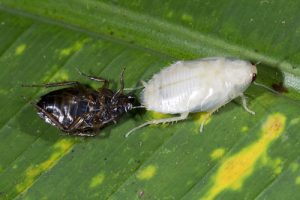How Insects Grow
By Chris Williams on February 27, 2012.
Q. I’m doing a science fair project on how insects grow. Do they all shed their skins to grow? How many times do they change skins before they’re grown?
A. All immature insects have to shed their skins in order to grow and eventually become adult insects capable of mating and reproducing. The outer covering of an insect’s body (called an exoskeleton) doesn’t expand. So, in order for an insect to grow, it has to shed its old exoskeleton (a process called molting) and replace it with a new one of a larger size. Other arthropods and even snakes shed their skins in a similar way.
 The number of times that an insect has to shed its skin varies with the type of insect, ranging from 3 molts in the house fly to 28 molts in some mayflies. Most insects molt 4 to 8 times. Each new stage of growth is called an instar. A German cockroach, for example, has 6 or 7 instars, meaning the nymph molts 6 or 7 times before it becomes an adult. Even insect larvae with soft skins have to shed them in order to grow. A house fly maggot will shed its skin 3 times before it becomes a fly. Sometimes, the shed skins can provide clues that an insect is present. For certain pests, like dermestid beetles, accumulations of old larval skins in food products or on the backside of a carpet may be the first sign of an infestation.
The number of times that an insect has to shed its skin varies with the type of insect, ranging from 3 molts in the house fly to 28 molts in some mayflies. Most insects molt 4 to 8 times. Each new stage of growth is called an instar. A German cockroach, for example, has 6 or 7 instars, meaning the nymph molts 6 or 7 times before it becomes an adult. Even insect larvae with soft skins have to shed them in order to grow. A house fly maggot will shed its skin 3 times before it becomes a fly. Sometimes, the shed skins can provide clues that an insect is present. For certain pests, like dermestid beetles, accumulations of old larval skins in food products or on the backside of a carpet may be the first sign of an infestation.
When an insect is about to molt, it looks for a hidden place. Molting can take hours, during which the insect is not able to protect itself. The old skin splits open down the back. Then the insect works to pull every part of its body, including its antennae and legs, out of the old skin covering. It’s a difficult process and the insect isn’t always successful. Some die during molting.
You’ve seen those brown, crinkly cicada skins that are attached to tree trunks or other objects. Most kids like to collect them. During its final molt, a mature cicada nymph crawls out of the ground and climbs up a vertical surface like a tree trunk. It attaches its front leg claws, the skin on the back splits, and the adult cicada gradually works its body out of the old nymphal skin, leaving just the empty skin behind.
After molting, the soft insect usually remains in hiding until its new, larger exoskeleton hardens and darkens. During this time, its new skin color gradually changes from almost white to its actual darker color. Even though each cockroach nymph molts 6 times, you see a pale, newly molted cockroach only rarely, usually when it’s been forced out of hiding by pesticides, predators, or overcrowding. Sometimes people mistakenly think that these newly molted insects are “albinos,” but they’re just normal insects in the process of growing up.